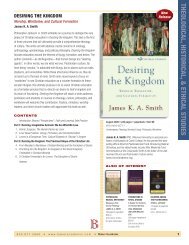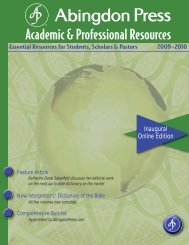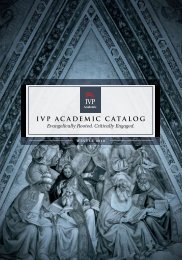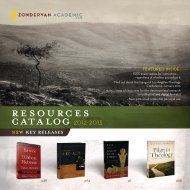koinonia
new releases
new releases
You also want an ePaper? Increase the reach of your titles
YUMPU automatically turns print PDFs into web optimized ePapers that Google loves.
04_Prom-Bless_17-22.qxd 6/15/12 11:01 AM Page 363<br />
BLACK SEA<br />
THRACE<br />
PONTUS<br />
MACEDONIA<br />
CAPPADOCIA<br />
ASIA MINOR<br />
ACHAIA<br />
MESOPOTAMIA<br />
LIBYA<br />
EGYPT<br />
JUDEA<br />
Jerusalem<br />
RED<br />
SEA<br />
SYRIA<br />
ARABIA<br />
SELEUCUS<br />
PTOLEMY<br />
CASSANDER<br />
LYSIMACHUS<br />
CASPIAN<br />
SEA<br />
MEDIA<br />
05_Prom_Bless_23-28.qxd 6/15/12 11:25 AM Page 478<br />
Bible Survey & Reference<br />
The Promise and the Blessing<br />
A Historical Survey of the Old and New Testaments<br />
Michael A. Harbin<br />
Having taught Old and New Testament survey courses for over twenty years, Michael A. Harbin has<br />
written a book to fill the need for a single text that overviews both Testaments in a unifying manner.<br />
The Promise and the Blessing traces the writing of the Bible as part of the history of the Israelite people<br />
and the nation of Israel, showing how the New Testament naturally flows out of the Old, not only<br />
theologically, but also historically. As such, the book follows a historical order rather than a strict<br />
canonical one.<br />
michael a. harbin (ThD and ThM, Dallas Theological Seminary) is the chair of the biblical<br />
studies, Christian education, and philosophy department at Taylor University. He is the author of To<br />
Serve Other Gods.<br />
DIGITAL<br />
FORMATS book • Image/map library<br />
TextbookPlus.Zondervan.com<br />
usd $49.99<br />
Hardcover • 688 pages<br />
ISBN 9780310240372<br />
biblical studies<br />
A E G E A N S E A<br />
B I T H Y N<br />
I A<br />
M E D I T E R R A N E A N S E A<br />
P H O E N I C I A<br />
EUPHRATES<br />
TIGRIS<br />
P E R S<br />
I A N G U L F<br />
In 305 BCE, after sixteen years as a nominal “satrap” or governor, Ptolemy I THE DIVISION OF<br />
took the title of “King of Egypt.” One of his most significant acts was to establish<br />
a major library in Alexandria, a city founded by Alexander the Great and AFTER HIS DEATH.<br />
ALEXANDER'S EMPIRE<br />
named after him. Alexandria also became a major settlement for Hebrews who<br />
did not go back to Judea. 16 His son, Ptolemy II Philadelphus (284–246 BCE),<br />
organized his father’s library and instituted major expansions and settlements.<br />
Manetho, a major Egyptian historian who provided records of the Egyptian<br />
dynasties, worked for him. It was during this time that the Septuagint (a Greek<br />
translation of the OT) was made.<br />
Wars between the Seleucids and the Ptolemies began during this period, but<br />
a tenuous peace was established when Philadelphus gave his daughter in marriage<br />
to Antiochus II of Syria. Just before Philadelphus’s death, she and her son were<br />
murdered. This act led to further conflicts for Ptolemy IV and V. Ptolemy V, a<br />
DANIEL AND THE EMPIRES<br />
The age of empires during the intertestamental period is shown by the four beasts<br />
in the vision of Daniel 7. Many scholars correlate the third beast (the leopard with<br />
four heads) with Alexander’s empire, which divided into several Greek-speaking<br />
kingdoms. It is seen in more detail in the vision of the goat and the ram in chapter<br />
8, where Daniel is told specifically that the ram represents Media and Persia, and the<br />
goat, Greece. The conflict between Syria and Egypt is traced in significant detail in<br />
Daniel 11 (for which reason scholars who do not accept prophetic revelation argue<br />
that it must have been written after the Maccabean revolt).<br />
Read Acts 16:11–15.<br />
PARTHENON. The most<br />
famous temple in Athens. It<br />
is actually part of a large<br />
complex of temples atop a<br />
large rock outcropping near<br />
the center of the city.<br />
hroughout the history of Christianity there have been significant events<br />
and locations marking changes in the direction of its growth. Philip’s trip<br />
Tto Samaria was one. Peter’s trip to Caesarea was a second. Barnabas’s trip<br />
to Antioch was a third. Paul’s vision at Troas was a fourth. Following this, Paul’s<br />
ministry circled the Aegean and moved westward toward Rome. While there was<br />
already a church in Rome itself, Paul started filling the spaces in between.<br />
FIRST CONVERTS IN PHILIPPI<br />
As soon as Paul’s companions agreed that his vision was a direction from God, the<br />
team took action. They caught a ship and sailed directly to the island of Samothrace<br />
and then to Neapolis, a coastal town in Macedonia. Their choice of a direct<br />
route indicates that they took advantage of a southeast wind. These ideal conditions<br />
would seem to confirm the choice they had made. From Neapolis, they traveled<br />
to Philippi.<br />
Luke notes that Philippi was both a Roman colony and a major city of the<br />
region. As a colony, it tended to follow carefully the leading of Rome. Since<br />
Claudius, the emperor, had cast the Jews out<br />
of Rome in 49 CE. (see Acts 18:2), it is possible<br />
that a similar decision was made in<br />
Philippi. 1 Consequently, when Paul and Silas<br />
arrived in the fall of 50, they did not find a<br />
synagogue in which they could follow their<br />
standard process. So on the Sabbath, they<br />
went outside the city, looking for “a place of<br />
prayer.”<br />
When they got to the banks of the Gangites<br />
River, where they expected to find a<br />
gathering of Jewish men, they found only a<br />
group of women. Never one to let an opportunity<br />
go by, Paul talked to them about Jesus.<br />
One of the women was a merchant of purple<br />
fabrics from Thyatira. 2 Her name was Lydia.<br />
The nature of her profession shows that she was a part of the upper socioeconomic<br />
group. She is also termed “a worshiper of God” (Acts 16:14).<br />
PHILIPPI<br />
This city, originally called Crenides, was founded in the fourth century BCE and then named after Philip II, king of<br />
Macedonia. It was reestablished by Mark Antony in 42 BCE after a battle that he and Octavian fought against Brutus<br />
and Cassius. Because of Roman expansion toward Thrace and incorporation of the Scythian tribes along the<br />
Black Sea (ca. 46 CE), it was a garrison city on the edge of the empire at the time of the emperor Claudius.<br />
also available:<br />
niv study bible<br />
usd $49.99<br />
Hardcover • 2560 pages<br />
ISBN 9780310438922<br />
CHAPTER 17: BRIDGES TO THE NEW TESTAMENT ◗ 363<br />
478 ◗ PART 2: THE BLESSING<br />
book<br />
is there a doctor<br />
in the house?<br />
Ben Witherington III<br />
usd $18.99<br />
Softcover • 160 pages<br />
ISBN 9780310493020<br />
book<br />
finding the lost<br />
images of god<br />
Timothy S. Laniak<br />
usd $14.99<br />
Softcover • 144 pages<br />
ISBN 9780310324744<br />
book<br />
the bible and<br />
the Land<br />
Gary M. Burge<br />
usd $14.99<br />
Softcover • 112 pages<br />
ISBN 9780310280446<br />
book<br />
83<br />
Purchase books for personal use for 50% off (Source Code 3D9CAT)













